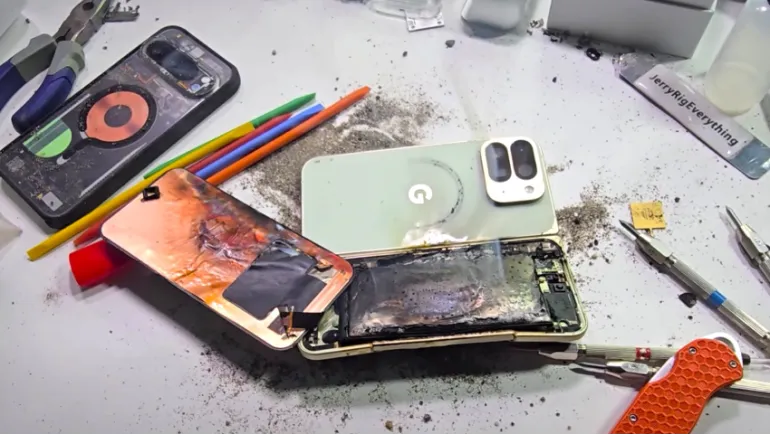
The Google Pixel 10 Pro Fold, Google’s most advanced foldable phone yet, has recently made headlines for all the wrong reasons. During a popular YouTube durability test, the flagship device unexpectedly exploded, sending smoke into the air and setting off a fire alarm. What was meant to demonstrate durability instead revealed a surprising flaw that no one saw coming.
When Google unveiled the Pixel 10 Pro Fold, the company highlighted its robust build, superior hinge design, and IP68 water and dust resistance — the first of its kind among foldables. The phone was marketed as both stylish and tough, promising years of smooth performance. But during JerryRigEverything’s infamous durability test, things took a fiery turn.
Popular tech YouTuber Zack Nelson, better known as JerryRigEverything, subjected the Pixel 10 Pro Fold to his standard series of scratch, dust, and bend tests. Initially, everything seemed fine. The outer Gorilla Glass Victus 2 cover performed as expected, and the flexible inner screen displayed similar scratch resistance to other foldables. However, when the bend test began, the situation quickly escalated.
Then came the shocking moment. Upon applying more force, the battery violently exploded, releasing thick white smoke that triggered the fire alarm in Nelson’s studio. The explosion was so intense that the YouTuber called it the first-ever smartphone explosion he had witnessed in over a decade of testing.
The explosion was not due to a design defect that affects everyday users but rather the result of extreme physical stress. Modern smartphones, including the Pixel 10 Pro Fold, use lithium-ion batteries, which are safe under normal conditions but can become hazardous if punctured or crushed.
When the Pixel was bent beyond its limits, it likely pierced or compressed the internal battery cells, creating an internal short circuit. This triggered a process called thermal runaway, where the battery heats uncontrollably, releasing gas and causing combustion. The white smoke seen in the video is a telltale sign of a lithium-ion battery failure.
Experts also note that if the device was fully charged during the test, the stored energy would have amplified the explosion’s intensity. The Pixel 10 Pro Fold’s battery is split across two halves of the chassis, connected by flexible wiring near the hinge. When that hinge area was twisted beyond tolerance, it effectively destroyed the battery’s structural integrity — resulting in the fiery outcome.
Following the viral video, tech experts were quick to point out that this explosion doesn’t represent a real-world risk for Pixel 10 Pro Fold owners. Durability tests like these are designed to push devices beyond their intended use cases to reveal potential weaknesses, not everyday hazards.
Analysts emphasize that consumers are unlikely to experience such a situation during normal use. The incident does, however, highlight how delicate foldable technology remains, even as it becomes more advanced. Compared to traditional smartphones, foldables have more moving parts and thinner internal layers, leaving less room for battery reinforcement.
Interestingly, Google has yet to release an official statement about the explosion. Still, industry observers expect the company to review its hinge design and possibly reinforce battery protection in future models. Given Google’s track record of addressing user concerns through software and design updates, a deeper investigation seems inevitable.
For everyday users, there’s no need to panic. The Pixel 10 Pro Fold remains safe under regular usage conditions. What this test does illustrate, however, is that foldables demand careful handling. Users should avoid over-bending, dropping, or applying excessive pressure to the hinge or display area.
Foldable technology continues to evolve rapidly, and incidents like this help manufacturers refine their designs. Just as early foldables struggled with screen creases and hinge durability, modern devices are now tackling thermal safety and mechanical resilience.
The Google Pixel 10 Pro Fold’s durability test may have ended with smoke and alarm bells, but it’s also a reminder of the risks inherent in pushing technology to its limits. The explosion was dramatic, but it doesn’t mean the phone is unsafe. Instead, it underscores the delicate balance between innovation, design complexity, and real-world durability.
As foldables become more common, companies like Google, Samsung, and others will undoubtedly learn from these extreme tests to make future devices even stronger and safer. For now, the Pixel 10 Pro Fold remains one of the most advanced foldables available — but this incident has certainly sparked an important conversation about how far we can bend our tech before it breaks.







Comments
There are no comments for this Article.